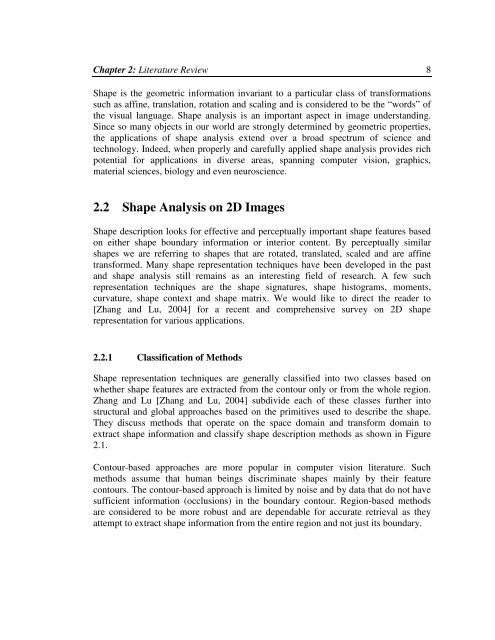To the Graduate Council: I am submitting herewith a thesis written by ...
To the Graduate Council: I am submitting herewith a thesis written by ...
To the Graduate Council: I am submitting herewith a thesis written by ...
You also want an ePaper? Increase the reach of your titles
YUMPU automatically turns print PDFs into web optimized ePapers that Google loves.
Chapter 2: Literature Review 8Shape is <strong>the</strong> geometric information invariant to a particular class of transformationssuch as affine, translation, rotation and scaling and is considered to be <strong>the</strong> “words” of<strong>the</strong> visual language. Shape analysis is an important aspect in image understanding.Since so many objects in our world are strongly determined <strong>by</strong> geometric properties,<strong>the</strong> applications of shape analysis extend over a broad spectrum of science andtechnology. Indeed, when properly and carefully applied shape analysis provides richpotential for applications in diverse areas, spanning computer vision, graphics,material sciences, biology and even neuroscience.2.2 Shape Analysis on 2D ImagesShape description looks for effective and perceptually important shape features basedon ei<strong>the</strong>r shape boundary information or interior content. By perceptually similarshapes we are referring to shapes that are rotated, translated, scaled and are affinetransformed. Many shape representation techniques have been developed in <strong>the</strong> pastand shape analysis still remains as an interesting field of research. A few suchrepresentation techniques are <strong>the</strong> shape signatures, shape histogr<strong>am</strong>s, moments,curvature, shape context and shape matrix. We would like to direct <strong>the</strong> reader to[Zhang and Lu, 2004] for a recent and comprehensive survey on 2D shaperepresentation for various applications.2.2.1 Classification of MethodsShape representation techniques are generally classified into two classes based onwhe<strong>the</strong>r shape features are extracted from <strong>the</strong> contour only or from <strong>the</strong> whole region.Zhang and Lu [Zhang and Lu, 2004] subdivide each of <strong>the</strong>se classes fur<strong>the</strong>r intostructural and global approaches based on <strong>the</strong> primitives used to describe <strong>the</strong> shape.They discuss methods that operate on <strong>the</strong> space domain and transform domain toextract shape information and classify shape description methods as shown in Figure2.1.Contour-based approaches are more popular in computer vision literature. Suchmethods assume that human beings discriminate shapes mainly <strong>by</strong> <strong>the</strong>ir featurecontours. The contour-based approach is limited <strong>by</strong> noise and <strong>by</strong> data that do not havesufficient information (occlusions) in <strong>the</strong> boundary contour. Region-based methodsare considered to be more robust and are dependable for accurate retrieval as <strong>the</strong>yattempt to extract shape information from <strong>the</strong> entire region and not just its boundary.
















